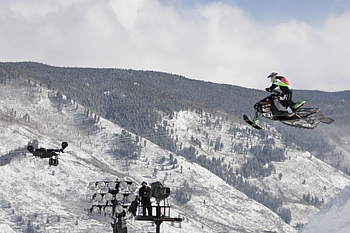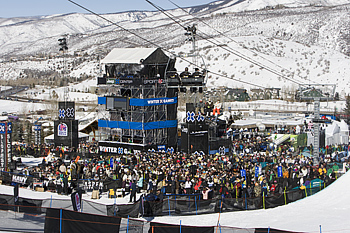'X'tra-Streamlined
ASPEN, COLO. ESPN is taking a more conservative approach to covering the 2009 Winter X Games, concentrating on cutting costs and streamlining the process for the 13th annual event, which takes place here, Jan. 22-25.
Efforts to minimize on-site equipment and man-hours will be achieved by expanding the network's tapeless workflow and incorporating previously unused technologies.
One bit of new eye candy thrown in for old time's sake will be virtual signage created by nine members of ESPN's Emerging Technology group. According to Michael Gay, the group's director of creative technology, the virtual 3D, computer-generated objects will include a giant X logo, virtual HD screens and sponsor logos. To create these, they're using Virtuous Technology's JS3000 camera encoding hardware and Brainstorm's eStudios graphics suite, which enabled similar projects for ESPN's College Game Day, NASCAR and Breeders Cup coverage.
At press time, the group was also working on an image recognition scheme called "Freeze Frame" to measure performances on the Half Pipe run. Cameras on either side of the course will provide overlapped fields of view; image processing techniques will create a "persistent trail" of a contender's trajectory to pinpoint and calibrate the apex of each jump, according to Chief Emerging Technology Engineer Peter Walsh. Data will be fed to the Huck Tower, where three operators will man the cameras and generate the graphics. Last year the team simply relied on cameras and monitors, Walsh said.

Freestyle snowmobiling will be among the extreme winter sport events held at the Winter X Games. Photos ©Rich ArdenXCENTER PATH
ESPN's Bristol, Conn.-based headquarters will factor more directly in the coverage thanks to the new "XCenter Path." The dual network will enable direct communication with Aspen using a terrestrial (T-1) baseband path, EVS' IP Director, a suite of database management tools, and an enhanced satellite backhaul connection. In short, the show can actually be switched from Bristol: ESPN headquarters will have full control over satellite content delivery and full data search capabilities.
"We're putting an IP Director at Bristol that's communicating with the servers back in Aspen," said Stephen Raymond, ESPN's coordinating technical manager. "And we're splitting up our satellite path using DVB-S2 modulation, so we're getting two paths out of every satellite transponder."
Raymond noted that this is the first time that the X Games crew has used a satellite-terrestrial pairing—and the first time the IP Director was placed in Bristol—for this purpose. He estimated that the newly created economies of scale will shave "about 80 percent" off the XCenter budget, while enabling the use of an extensive crew and un-transportable equipment.
Also streamlining the process are "bin rules" that have been set up using IP Director, which enables automatic delivery of "great moments as they are happening" to recipients in Aspen or Bristol based on key words, camera angles, content and other flags, according to consultant Greg Blanton, owner, Dallas-based Blanton Video Enterprises-Broadcast Fusion, a consultant.
"Delivery can be to a folder all the way to the Avid Unity or EXPN for Web content," Blanton said.
FIRST TIME OPTIONS
The crew will also test NL Technology's AutoIngest software to extract footage from tapeless ENG systems for transfer (via Avid Interplay/Transfer Manager stand alone server) to Avid's Unity Media Network.
"We're using AutoIngest to move P2 files directly from the DVCPRO HD format, transcode them into DMX, and place them on the Unity," said Raymond. "It's the first time we're going to use it."
It will also be the first time that the X Games uses Final Cut Pro to create highlights and bumps-on-the-fly in production trucks. Previously, reels were created directly on EVS machines, with an EVS operator manipulating an LSM controller.

Aspen/Snowmass will once again serve as the venue for ESPN's Winter X-Games. "That is a very limited editing interface: you pretty much get to pick between cuts and dissolves, and audio edits are very difficult to do properly," said Harris Upham, independent post production technology consultant. "We're going to attach these relatively simple Final Cut systems to give a little more editing flexibility to those operators. And turnaround time is going to be dramatically reduced."
An all-fiber path will run from remote interface (input/output) boxes to the TV compound and on to Bristol, thanks to arrangements with Calrec Audio, Lance Design (Cobranet-based network) and NEP Broadcasting. Copper will only connect the I/Os to the microphones.
"It will save us mightily in the cost of labor associated with laying thousands of feet of copper cable as well as [provide] many more resources," said ESPN/X Games Operations Manager Severn Sandt.
Kevin Cleary, event operations senior technical audio producer for ESPN expects a huge improvement in audio perception—and convenience.
"Calrec's Hydra [audio networking system] allows you to adjust gain, add phantom power, and EQ a particular microphone from a console in the truck," he said. "In the past you always had to have someone at the remote box setting gain and levels."
In addition, he said, "having all of the venues on this network allows us to give any of the trucks access to any of the microphones. So if we have any failure on one of the trucks, it would not be a big deal for another truck to grab the microphones off the Hydra net and mix it."
Cleary and Henry Rousseau, senior technical producer for ESPN Event Operations, were also impressed by the system's multichannel audio digital interface (MADI).
"The MADI lets us pass audio signals between all the trucks on a single coax cable," said Rousseau. "And in terms of man-hours, it's a lot easier to run a single coax cable between the trucks than a heavy DT12 cable."
And because that single coaxial cable carries 64 channels of audio as opposed to 12, it basically takes the place of more than five DT12 cables, which translates into huge savings in shipping costs as well as man-hours, according to Cleary.
RF OVER FIBER
Total RF subsidiary CP Communications will provide the infrastructure for both the remote audio and video portions of the Winter X Games. The company plans to set up a central location to receive signals from wireless microphones, IFBs and even footage from the X Games' signature FollowCams, whose skiing operators track contenders down the slopes.
At press time, CP Communications in Elmsford, N.Y., was partnering with U.K.-based Gigawave to create a new FollowCam, using a modified Sony FCB-H11 housed in an element-proof box, according to Kurt Heitmann, vice president of sales and marketing for CP Communications.
The professional video industry's #1 source for news, trends and product and tech information. Sign up below.
